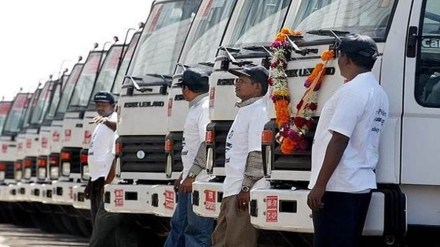Key Commercial vehicle stocks like Ashok Leyland, Tata Motors are in focus after BNP Paribas said that the reduction in GST rates is expected to have a limited impact on the demand for Commercial Vehicles (CVs), especially the Medium and Heavy Commercial Vehicle (MHCV) segment. You may ask why?
This is primarily because CV buyers are businesses that most of the time claim an input tax credit on it, which makes GST a pass-through cost for the CV buyers. The automotive industry currently faces an average 28% GST rate, barring select pockets like 5% for EVs. All eyes are now on the future rates that are awaited.
However, some customers in the Light Commercial Vehicle (LCV) and Intermediate Light Commercial Vehicle (ILCV) segments are not big enough to claim GST returns. Therefore, these sections could potentially benefit from tax reduction.
GST reforms likely by December
The proposed changes in GST may include moving to two main GST slabs, 5% and 18%, with a 40% rate for “sin goods,” and potential changes to the compensation cess. Structural reforms aim to correct inverted duty structures (ex., for EV manufacturing) and streamline GST processes.
BNP Paribas estimates a high likelihood of the proposal being approved by the GST council, expecting it to receive more than the required 75% of weighted votes.
Demand impact on passenger vehicles
Drawing lessons from a 2006 excise duty reduction, the report notes that a 10 percentage point (ppt) cut in GST for sub-4-meter cars (from 28% to 18%) is expected to result in a price elasticity of approximately 2x, leading to significant volume growth.
This change would benefit 62% of the PV industry’s FY25 volume. BNP Paribas expects that the key beneficiaries are expected to be Maruti Suzuki, Hyundai India (NC), and Tata Motors in the PV segment.
Demand impact on two-wheelers
The Two-Wheeler industry has an estimated price elasticity of around 1.6x, as per BNP Paribas, with higher elasticity in the entry segment. A GST rate cut of 10 percentage points for up to 125cc 2Ws (from 28% to 18%) is projected to show a price elasticity of 2x. The likely beneficiaries are Hero MotoCorp and Bajaj Auto.
Demand impact on Electric Vehicles (EVs)
A GST rate reduction for Internal Combustion Engine (ICE) vehicles could reduce the existing tax arbitrage between ICE and Electric Vehicles (EVs), potentially making EVs less favourable. For instance, the arbitrage for electric two-wheelers could decrease to 13% from 23% and for ePVs to 14% from 24% in the sub-4-meter segment. Key stocks to watch in this segment include the likes of Ather Energy, TVS Motor and Ola Electric.
Lack of clarity to postpone purchases
However, there is no clarity on the exact GST rates at the moment. The current lack of clarity on GST taxation could lead customers to postpone purchases in the near term. This could potentially affect the demand during the upcoming festival season. Not just that, this uncertainty may also create inventory issues for OEMs who are building stock in anticipation of higher sales during the festival season.
All in all, BNP Paribas does not anticipate significant demand woes for the CV industry as a whole due to GST rate changes. However, in the near term, buyers could postpone purchases due to a lack of clarity on the GST taxation structure.
